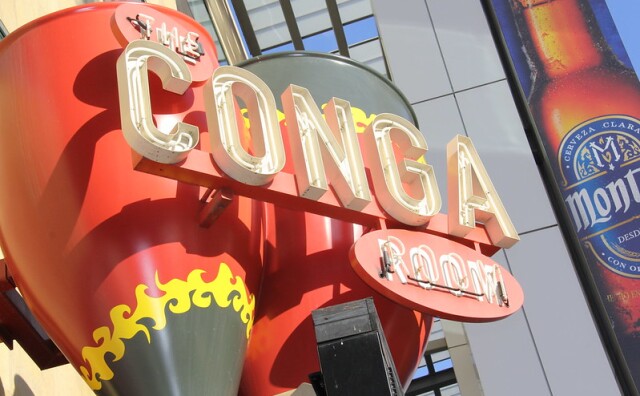-
This is the third story in a series of articles looking at the surprising history of K-pop, pegged to the release of K-Pop Dreaming, the new podcast series from LAist Studios.
If you retrace how K-pop came to embody a diversity of worldwide cultural influences, you end up somewhere entirely unique: a hip-hop nightclub for Black American GIs in the heart of 1980s Seoul, South Korea — called Moon Night.
Founded in 1989, Moon Night was the site of a burgeoning hip-hop dance scene in Seoul. And for K-pop, the little nightclub holds unrivaled significance.
Listen to the podcast
“Moon Night, you can kind of consider it to be the incubator of what contemporary pop music is for Korea today,” said Kyuhee Baik, culture observer and writer in Korea.
The club was the nexus of many K-pop legends, including Hyun Jin Young and Wawa, CLON and DEUX — some of the most influential dance music groups in the 1990s. And the club brought together future architects and shapers of early K-pop. These music producers would go on to establish the “Big 3” entertainment companies of K-pop: SM, YG and JYP.
Hyun Jin Young and Wawa (현진영과 와와)
Moon Night was the place where Seo Taiji and Boys — often heralded as the start of modern K-pop sound — hung out.
Seo Taiji and Boys (서태지와 아이들)
And what were all these future movers and shakers doing at a hip-hop club in the late ‘80s and early '90s? They were there to learn dance from the Black American GIs stationed in Seoul.
But in order to understand how Moon Night was able to exist, we need to take a step back to take a look at the political and cultural climate in South Korea leading up to that point.
U.S. military in South Korea

After WWII, the U.S. military stationed itself in what is now South Korea and established its headquarters in the capital city of Seoul, specifically in a military compound located next to a neighborhood called Itaewon. From the 1950s onward, Itaewon developed into an area where American soldiers liked to hang out.
-
Nonprofit's launching fundraiser to keep it afloat
-
USC study documents what residents want from trees
-
What candidates can — and can't — say they do
“Itaewon was very much a space to cater to the U.S. military. So like everything from strip clubs to prostitution, to bars or clubs, like it was all happening around there so that the U.S. military could feel at home,” said Baik.
Moon Night was one of those clubs. It was a spot for Black GIs to listen and dance to hip-hop, rap and new jack swing.
But beyond physical proximity to the American soldiers located in South Korea, there was an influx of American culture coming in other ways.
Those included USO shows, shows that the United Service Organizations would arrange for American performers to entertain troops overseas, made famous by Bob Hope, who headlined performances for decades. The shows became so popular among troops that the demand exceeded the number of performers available to perform, so Korean performers were called in to fill the gap.
Eventually, those Korean USO performers started performing for Korean audiences. They brought the repertoire popular among American soldiers, which included Black American music, to the rest of South Korea.
“American military presence brought American culture, which was saturated with Black popular culture at the time,” said Crystal Anderson, author of the book, “Soul in Seoul: African American Popular Music and K-pop."
"Any time you have the presence of American culture, you also are going to have the presence of African American culture because the two are really intertwined," Anderson said.
The Korean Kittens performing Ray Charles
Another major channel for American culture entering the country was a TV and radio network set up by the U.S. military, called the American Forces Korea Network, or AFKN.
AFKN, which was set up in 1953, had news programs run by U.S. servicemen and women in uniform. AFKN also played popular American TV shows. The channel wasn’t limited to soldiers on base, it was also piped into Korean homes. Korean viewers would tune in for a variety reasons — and some came to watch the network’s music programs.
How one K-pop legend got hooked on hip-hop
One of these devoted Korean viewers was a young dancer named Kang Won Rae, an early K-pop legend and a member of the influential '90s dance duo CLON.
“I used to follow dances on programs such as Soul Train, Solid Gold, Apollo,” Kang Won Rae told us in Korean.
Eventually, Kang got hooked on hip-hop in the '80s, and in 1989, one place Kang could experience the music in the flesh was Moon Night.
Kang Won Rae describes Moon Night as a basement club that you could hear vibrating with bass even from the outside. The club’s entrance was guarded by bouncers, and it was tough for Korean locals to get in unless you knew somebody.
Kang Won Rae remembers the club as hot and filled with cigarette smoke. The checkerboard dance floor was filled with mostly Black American GIs dancing to music, including gangster rap or new jack swing. Not only were Black American GIs dancing among themselves, but they were also teaching Korean locals how to dance, too.
“When Bobby Brown songs, or MC Hammer, or Heavy D songs were playing, everyone danced, in our words, the ‘Bunny Dance,’ they danced and had a great time,” explained Kang Won Rae.
The “Bunny Dance,” as it’s called in Korean, is what Americans know as “The Running Man.”
The coveted spot in front of the big fan
Kang Won Rae says there was only one air conditioner in the corner of the club, and a giant electric fan that brought the cool air to the dance floor. The best dancers in the club would be able to get the coveted spot in front of that fan. Kang Won Rae himself worked to perfect his moves until he earned that spot.
He remembers seeing so many K-pop legends at Moon Night. At the time, most of these would-be pioneers were just starting out. The list of iconic dance artists, singers and music producers that hailed from Moon Night goes on and on. That list includes the very first K-pop act to exist.
“Seo Taiji. He came to Moon Night. He came there to get a feel about dancing,” he said.
An unclear end for a fabled club
Moon Night eventually closed down sometime in the mid-1990s. There isn’t a lot of information about what happened, and like many of the fabled birthplaces for now-ubiquitous music genres, Moon Night now has a mystical nature about it. There’s limited pictures or videos of the actual place. But there are details that line up from people who had actually been there — namely, the checkerboard floor, giant electric fan and the music that flooded the club.
“People forget that hip-hop was at the beginning at the birth of K-pop. Without hip-hop, you would not have K-pop,” said Anderson.
Moon Night’s impact continues on past its physical limitations. The influence of Black American hip-hop music on the creation and development of K-pop continues to this day.
“K-pop, I think, speaks to the global spread of hip-hop in the 1990s,” said Anderson. “My book talks about the way that K-pop draws on R&B and hip-hop genres of Black popular music, and it talks about it in terms of how authentic it is. So much so, we can consider K-pop to be a global branch of those R&B and hip-hop genres.”
The authenticity question
This question of authenticity is something that comes up a lot when people talk about the influence of Black music on K-pop — and where the genre falls on the spectrum of appreciation versus appropriation.
Anderson says not every K-pop group has that authentic connection to Black music, but some groups do. She points to the first-generation K-pop group g.o.d. as an example. The song “Intro” on their first album samples The Gap Band’s “Outstanding.”
“If you've ever been to a Black cookout, at some point, somebody is going to put ‘Outstanding’ on somewhere. So it's that quintessential,” said Anderson. “So it's like, you had to choose it knowing what kind of resonance that it had.”
For Anderson, g.o.d. sampling The Gap Band is evidence of the group’s deep connection to Black American music and culture. That connection was possible in no small part because of one little nightclub in Itaewon.
“The impact that these places had on what's modern day K-pop, it's undeniable,” said Bernie Cho, a music executive in Seoul. “Underground clubs really had a deep impact and deep influence on artists, producers, songwriters, musicians and dancers.”
Part of the magic surrounding the club is that it could only exist at this one particular moment in time. Its very existence was a result of so many different geopolitical factors — the Japanese occupation, WWII, which led to a permanent American military presence, shaping the neighborhood of Itaewon.
All of this led to the formation of this little nightclub where Koreans would frequent, immersing themselves in hip-hop — the music that would go on to shape the identity of K-pop.
-
Listen to all of LAist Studios’ new podcast, K-Pop Dreaming. Host Vivian Yoon follows the rise of K-pop through the perspective of the Korean American diaspora in Los Angeles.










